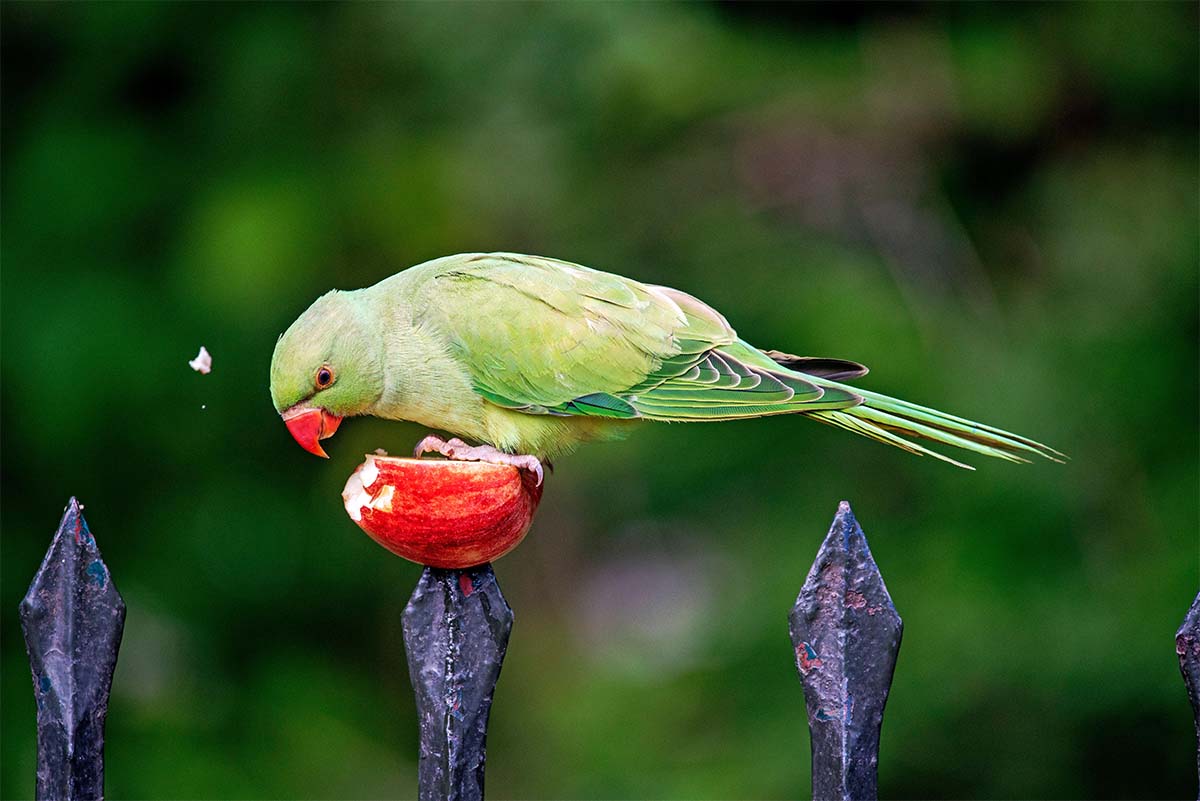Ring-necked parakeets and monk parakeets – are they colonising the country?
Parakeets are becoming an increasingly familiar sight in many of our cities and the surrounding areas

Parakeets are growing in numbers across many parts of the UK
Ring-necked parakeets (or rose-ringed parakeets) are unmistakeable with predominantly green plumage, long tail and pointed wings in flight. Closer-to, the beak is red while a pink and black ring surrounding the head and neck provide its name.
The somewhat smaller monk parakeet is less widespread and easily distinguished by an orange beak, bright green upper parts and pale grey forehead and breast, and light green to yellow rear underparts.
The raucous and unmelodic calls of both types of parakeet are typically parrot-like and are unlikely to be mistaken for those of any of our native species. (Read is it legal to shoot parakeets?)
How did ring-necked parakeets get here?
How two species of parrot from South America, central Africa and the Indian sub-continent made it to this country has been the subject of a great deal of urban myth. It has been suggested that they escaped from Isleworth film studios in Middlesex during the 1951 filming of The African Queen with Humphrey Bogart and Katharine Hepburn, while others claimed that a plane crashed through the roof of an aviary at nearby Syon Park, releasing a flock kept captive there.
It’s even been said that legendary musician Jimi Hendrix released them in Carnaby Street during the Swinging Sixties.
The truth is, sadly, rather more mundane and it is far more likely that a series of escapes of pet birds – parakeets having been popular since Victorian times – was responsible for the establishment of a breeding population in this country.
The new arrivals coped well with the colder British winters and were further assisted by the reliable food supplies found in gardens, parks and orchards. Bird feeders can be an important food source in winter when natural forage is scarcer and a wide variety of scraps may be taken.
Thriving
No matter how they got here, parakeets have thrived. Ring-necked parakeets have done especially well, as befits a bird adaptable and robust enough to live in the foothills of the Himalayas, and the ring-necked parakeet is now by far the most widely distributed and numerous of the two.
Ring-necked parakeets are believed to have started breeding in Kent in 1969 since when numbers have swelled to around 9,000 pairs. Most daily activity takes place in the early morning or late afternoon and they are often encountered in noisy roosting flocks containing many hundreds of birds.
The monk parakeet has a far more limited distribution and seems to be confined to the Home Counties where numbers may be no more than a few hundred.
Not welcome
Attractive and unusual they might be, but these non-native parakeets present a serious threat to our native wildlife. As early nesters, sometimes laying as early as January, they have an advantage as there is little competition for nest holes that early.
An old woodpecker nest hole is often chosen, and they frequently displace other species such as owls and starlings that use similar nest sites. Dominant and aggressive, they are alternately loved and hated by people who see them bullying other birds off their garden feeders.
In addition to taking over nesting sites, there is particular concern about them out-competing roosting bats. As they colonise new sites the bats are often killed. There is also considerable potential for damage to farmlands and orchards, and fruit growers in particular suffer from raids on their crops.
As a result, both parakeet species may be controlled under specific general licences. It is now illegal to release or allow either species to escape into the wild. Should you find yourself in a position where you need to control parakeets, shooting is not overly challenging. The flight speed is half that of a woodpigeon and tends to be steady and direct. Despite considerable research it has not been possible to come up with a parakeet recipe, so maybe one of our Sporting Gun readers might be able to advise on this bird’s table qualities?
Monk and ring-necked parakeets facts
- Distribution: The ring-necked parakeet is native to central Africa and across the Indian sub-continent from Pakistan to Myanmar, while the monk parakeet comes from South America. Both species are now widely established in other parts of the world, largely as a result of escapes.
- UK Distribution: Greater London and its surrounding areas remain the main stronghold of the ring-necked parakeet though it has now been recorded in almost every county of England as well as parts of Wales, the Borders and as far north as Edinburgh. The monk parakeet remains, for now, restricted to the Home Counties in small numbers.
- IUCN: Red List status Least Concern, numbers increasing (both species) Ring-necked parakeet:
- Habitat: Very adaptable, often frequenting farmland, orchards, parks and gardens.
- Food: Buds, fruits, seeds, berries, nuts and vegetables.
- Breeding: Pairing takes place between September and December. Ring-necked parakeets do not pair for life and often breed with different partners in successive seasons.
- Nesting: A simple nest is made in a tree hole (monk parakeets build a stick nest in a tree or man-made structure). Both parents care for the young which fledge after around seven weeks but may not be fully independ- ent for up to two years. They do not usually reach reproductive maturity until three years old.
- Clutch: Size 2-5 eggs.
- Incubation Time: Around 21 days.
- Length (average): 38-42cm.
- Wingspan (average): 42-48cm.
- Weight (average): 110-130g.
- Lifespan (average): 25-30 years.
- Flight Speed: Around 23mph.
- Shooting Seasons: Can be killed or taken throughout the year under the terms and conditions of specific general licences to conserve birds of conservation concern, conserve fauna (ring-necked only), protect public health and safety (monk only), or protect crops, fruit and vegetables.








